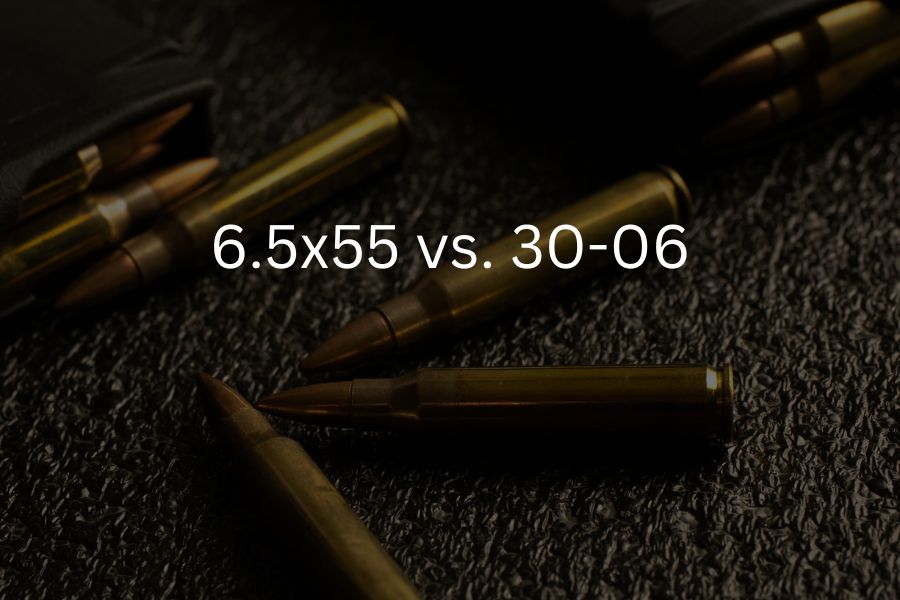When it comes to choosing a hunting or shooting rifle, there are many factors to consider, including caliber. Two popular calibers for hunting and shooting are the 30-06 and the 6.5×55. While the 30-06 is a well-known and popular cartridge in the United States, the 6.5×55 is a European classic that has gained a reputation for its accuracy and versatility. In this article, we will compare the 30-06 and the 6.5×55 to help you decide which cartridge is right for you.
Here is the short answer:
The 30-06 is a versatile and powerful cartridge that is suitable for hunting a wide range of game, including large and dangerous animals. The 6.5×55, on the other hand, is a highly accurate and efficient cartridge that is ideal for hunting medium-sized game at longer ranges.
Since we have looked at the short answer, we can look in depth at each cartridge, what their best uses are, their ballistics, and how they compare.
Analysis of the 30-06
For over one hundred years, the 30-06 Springfield cartridge has been a staple in hunting and shooting circles. It was initially introduced in 1906 to much fanfare from hunters, target shooters, and the military alike due to its versatile capability. At present time, this cartridge is used widely by those involved with hunting medium-to-large game like deer, elk, moose, or bear as well as wild boar and similar-sized animals.
The weight of available bullets for this cartridge spans from 110 grains up to 220 grains giving users a wide selection depending on their needs; accordingly, its utility ranges from small varmints like coyotes all the way to large dangerous game like grizzly bears, although a bigger caliber is often recommended for game like grizzly bears. Furthermore, due to having less recoil than some cartridges in that same size range (such as .300 Win Mag), it is also an excellent option for beginner shooters wanting to learn accuracy without being intimidated by excessive kickback.
Here is a ballistics chart of the 30-06 with a 180-grain soft point:
| Range (YD) | drop (IN) | wind drift (IN) | velocity FPS | energy ft-lb |
| 0 | -1.5 | 0 | 2700 | 2913 |
| 50 | -0.1 | 0.2 | 2584 | 2668 |
| 100 | 0 | 0.9 | 2470 | 2439 |
| 150 | -1.3 | 2 | 2359 | 2225 |
| 200 | -4.2 | 3.7 | 2252 | 2026 |
| 250 | -8.8 | 6 | 2147 | 1842 |
| 300 | -15.3 | 8.8 | 2045 | 1671 |
| 350 | -23.8 | 12.1 | 1945 | 1512 |
| 400 | -34.6 | 16.2 | 1848 | 1365 |
| 450 | -48.1 | 21.2 | 1756 | 1232 |
| 500 | -64.6 | 27 | 1667 | 1111 |
Analysis of 6.5×55 Swedish
The 6.5×55 Swedish continues to be widely appreciated by shooting enthusiasts around the world owing to its impressive history and performance attributes; indeed, over a century after its inception, this particular caliber retains widespread popularity amongst hunters and target shooters alike who value accuracy combined with milder felt recoil than found in comparable magnum calibers used for big game hunting requiring longer ranges shots taken from field positions on potentially dangerous animals 6.5x55mm is characterized by a 264 caliber bullet with a 55 mm case length and an approximate weight of 21 grains loaded with smokeless powder.
This round quickly gained popularity due to its accuracy at longer ranges, as well as for the flat trajectory it provides in open terrain settings, making this caliber ideal not only for hunting game like deer but also serving military forces around Europe who adopted variants of it during World War I & II – notably Norway, where today it remains their standard battle rifle cartridge.
Here is a ballistics chart of the 6.5×55 with a 156-grain soft point:
| Range (YD) | drop (IN) | wind drift (IN) | velocity FPS | energy ft-lb |
| 0 | -1.5 | 0 | 2500 | 2165 |
| 50 | 0 | 0.2 | 2412 | 2015 |
| 100 | 0 | 0.7 | 2326 | 1874 |
| 150 | -1.6 | 1.8 | 2242 | 1740 |
| 200 | -5 | 3.3 | 2159 | 1614 |
| 250 | -10.2 | 5.2 | 2078 | 1496 |
| 300 | -17.5 | 7.7 | 1999 | 1384 |
| 350 | -26.6 | 10.3 | 1921 | 1278 |
| 400 | -38.3 | 13.7 | 1845 | 1179 |
| 450 | -52.7 | 17.9 | 1772 | 1088 |
| 500 | -70 | 22.7 | 1702 | 1003 |
Comprehensive Comparison Between 30-06 and 6.5×55 Swedish
Upon considering a rifle cartridge for selection, numerous hunters find themselves perplexed between the 30-06 and 6.5×55 Swedish cartridges. It is imperative to gain an understanding of their respective benefits and drawbacks so as to make a well-informed decision.
The 30-06 round has been in existence since 1906 yet remains extensively employed presently; it possesses an appreciably sizable bullet diameter which permits higher velocities than other similarly sized ammunition models, thus rendering it suitable for hunting larger animals like deer or elk at longer distances.
The downside of the 30-06 is that its recoil can be quite heavy in comparison to other cartridges with similar power levels, necessitating shooters to practice adequate techniques for controlling recoil in order to make optimum use of this round.
Conversely, the 6.5×55 Swedish has been available since 1894 and while not as widely popular as the 30-06, it still maintains a devoted fan base among hunters due to its remarkable accuracy and low-felt kickback even though it does not generate output at high force comparable with rounds like .308 Winchester or 300 Win Mag.
Furthermore, because the 6.5×55 Swedish bullet diameter is significantly smaller than that of a 30-06 cartridge this allows users greater flexibility when selecting lighter bullets which are more accurate yet maintain sufficient energy once they reach their intended target; rendering it an ideal option for shooting activities requiring utmost precision such as long-range hunting or competitive shootouts where pinpoint accuracy takes precedence over sheer energy generated from one’s ammo preference.
Conclusion
In conclusion, it can be said that the 6.5×55 Swedish and the 30-06 represent two excellent cartridges with a number of special benefits in certain contexts. Both can suitably serve for hunting, target practice and competition shooting alike. Their respective ballistics are fairly equivalent which means many shooters ought to find either one appropriate according to their needs. Thus ultimately, when determining which caliber debate should be chosen for an upcoming rifle acquisition or ammo reloading assignment, a preference based on individual taste is likely most determinative factor

